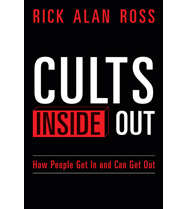The Cult Content Boom: What’s Behind Our Obsession?
Published By admin
From streaming documentaries to bestselling books and theatrical productions, cults are trending. The groups have become a dominant force in contemporary media, reflecting deeper societal anxieties and a search for meaning in a world that can often feel disconnected.
The International Cultic Studies Association estimates that up to 3% of people are involved in a cult at some point in their lives. Accurate data is scarce, given that members of groups rarely self-identify. The definition of a cult can also vary widely. Is cult membership increasing, or has awareness and reportage of the groups climbed?
What is measurable is the exponential growth in public interest around cults. Streaming platforms have released dozens of high-profile productions in recent years, reflecting audience demand. The stories are compelling, often blending sure-fire elements of true crime, psychology (primarily the surrender and loss of self, replaced with a groupthink mentality), deception, betrayal and all manner of drama.
Netflix has cornered the cult documentary genre, releasing productions like Wild Wild Country (2018), which examined the Rajneeshpuram commune headed by Indian guru Bhagwan Shree Rajneesh. Also, Bad Vegan: Fame. Fraud. Fugitives. (2022) and How To Become A Cult Leader (2023).
The number of shows goes on, produced by Netflix and other streamers. The shortlist: Bad Faith (Amazon Prime, 2024); Born in Synanon (Paramount+, 2023); The Family (Netflix, 2019); Breath of Fire (HBO, 2024); Heaven’s Gate: The Cult of Cults (HBO, 2020); Desperately Seeking Soulmate: Escaping Twin Flames Universe (Amazon Prime, 2023) and Leah Remini: Scientology and the Aftermath (A&E, 2016).
Further back, there are numerous documentaries about the world’s most well-known cult, the Peoples Temple, led by Jim Jones, given the mass murder-suicide of more than 900 of its members in Guyana in 1978. The standout documentary mini-series on the cult was recently released in 2024, reflecting renewed interest: Cult Massacre: One Day in Jonestown (Hulu). The three-episode production includes rare archival footage and recordings of Jones, along with survivor and eyewitness interviews.
What’s behind the fixation with cults? “The fascination with cults fundamentally rests in the idea that people believe that they can’t be drawn into one,” says Dr. Mara Einstein, author of Hoodwinked: How Marketers Use the Same Tactics as Cults (Prometheus, 2025). “The first step in the recruitment process is to find vulnerable people. We are all vulnerable at some point in our lives—we’ve moved to a new town, gotten a divorce, lost a loved one—which means we could all be lured into a cult.”
The definition of cult has broadened, fueling greater interest. About 50 years ago, a cult was equated with the word “dangerous.” Think Jim Jones, the Branch Davidians in Waco, Texas and the Manson Family cult led by Charles Manson. “Because of digital media, the definition has expanded to be closer to the 17th century one, when cults were groups that venerated a person or ideology,” says Einstein, who is a professor at Queens College, City University of New York.
Beyond documentaries, the book market has weighed in: academic analyses, books on how to identify cults and help loved ones, along with memoirs. The New York Times bestselling memoir Stolen Innocence by Elissa Wall (William Morrow, 2008) relays life inside Utah’s FLDS polygamist sect. The author’s courtroom testimony helped convict sect leader Warren Jeffs in 2007.
Content retrieved from: https://www.forbes.com/sites/rdaniel-foster/2025/07/01/the-cult-content-boom-whats-behind-our-obsession/.






